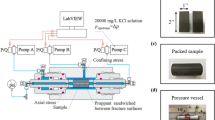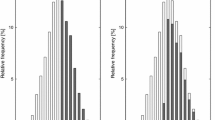Abstract
The recovery of unconventional natural gas is a potential solution to the increasing worldwide energy demand and therefore plays a crucial role in the global energy landscape. However, the rapid reduction of production often experienced during the initial recovery phase of unconventional natural gas resources is a major concern. Therefore, an advanced understanding of realistic fracture characteristics and flow behaviour in hydraulically fractured shale and siltstone formations has become a subject of interest. This paper reports on the adoption of 3-D synchrotron imaging, 3-D fracture surface scanning, and statistical analysis to study the fracture morphology and characteristics of hydraulically induced fractures. The fractures generated in siltstone specimens exhibited fracture surfaces with high surface roughness (Joint Roughness Coefficients (JRCs) of 9–12) compared to shale formations (JRCs of 1.3–1.7). In addition, whatever the type of formation, hydraulic fracturing generates fractures with varying fracture profiles and fracture complexities. 3-D synchrotron imaging was utilized to measure the tortuosity of fractured specimens. Flow behaviour in proppant-filled fractures was studied to evaluate the influence of different proppant concentrations, fracture tortuosities, and confining stresses. Importantly, for low-proppant concentrations and high confining stress levels, the severity of fracture tortuosity determines the overall flow behaviour in fractures. The results reveal that fracture permeability increases by a magnitude of 20.62 and 28.4 darcy, when fracture tortuosity varied from 8.4 to 3.8 and 7.4 to 3.2, respectively. Furthermore, an increase of proppant concentration from 40 to 80% proppant coverage increased fracture permeability by a magnitude of 40.81 darcy, whatever the tortuosity of the fracture. 3-D synchrotron imaging of fractured permeability-tested specimens detected the greater crushing of proppants in low proppant-concentrated fractures than higher proppant-concentrated fractures.











Similar content being viewed by others
References
Alramahi B, Sundberg MI. Proppant embedment and conductivity of hydraulic fractures in shales. In: 46th US rock mechanics/geomechanics symposium 2012, 2012, pp 657–662
Assem AI, Nasr-El-din HA (2017) Interactions between different acids and bauxitic-based ceramic proppants used in gravel-packed and fractured wells. J Petrol Sci Eng 158:441–453
Bandara KMAS, Ranjith PG, Rathnaweera TD (2020a) Extensive analysis of single ceramic proppant fracture mechanism and the influence of realistic extreme reservoir conditions on proppant mechanical performance. J Petrol Sci Eng 195:107586
Bandara KMAS, Ranjith PG, Rathnaweera TD (2020b) Laboratory-scale study on proppant behaviour in unconventional oil and gas reservoir formations. J Nat Gas Sci Eng 78:103329
Bandara KMAS, Ranjith PG, Rathnaweera TD, Wanniarachchi WAM, Yang SQ (2020c) Crushing and embedment of proppant packs under cyclic loading: an insight to enhanced unconventional oil/gas recovery. Geosci Front (in press)
Donaldson E, Alam W, Begum N (2013) Hydraulic fracturing explained: evaluation, implementation and challenges. Elsevier
Duenckel R, Conway MW, Eldred B, Vincent MC (2011) Proppant diagenesis- integrated analyses provide new insights into origin, occurrence, and implications for proppant performance. In: Society of petroleum engineers—SPE hydraulic fracturing technology conference 2011, pp 98–124
Fu L, Zhang G, Ge J, Liao K, Jiang P, Pei H, Li X (2016) Surface modified proppants used for porppant flowback control in hydraulic fracturing. Colloids Surf A 507:18–25
IEA (2018) World Energy Outlook 2018. International Energy Agency
IEO (2016) International Energy Outlook 2016, with projections to 2040. Government Printing Office
Isaka BLA, Ranjith PG, Rathnaweera TD, Perera MSA, De Silva VRS (2019) Quantification of thermally-induced microcracks in granite using X-ray CT imaging and analysis. Geothermics 81:152–167
Isaka BLA, Ranjith PG, Wanniarachchi WAM, Rathnaweera TD (2020) Investigation of the aperture-dependent flow characteristics of a supercritical carbon dioxide-induced fracture under high-temperature and high-pressure conditions: a numerical study. Eng Geol 277:105789
Khanna A, Keshavarz A, Mobbs K, Davis M, Bedrikovetsky P (2013) Stimulation of the natural fracture system by graded proppant injection. J Petrol Sci Eng 111:71–77
Lacy LL, Rickards AR, Bilden DM (1998) Fracture width and embedment testing in soft reservoir sandstone. SPE Drill Compl 13:25–29
Lane W, Chokshi R (2014) Considerations for optimizing artificial lift in unconventionals. In: SPE/AAPG/SEG unconventional resources technology conference. Denver, Colorado, USA: Unconventional Resources Technology Conference
Liang F, Sayed M, Al-Muntasheri GA, Chang FF, Li L (2016) A comprehensive review on proppant technologies. Petroleum 2:26–39
Lobo-Guerrero S (2006) Evaluation of crushing in granular materials using the discrete element method and factal theory. Doctoral dissertation, University of Pittsburgh
Ma Z, Gamage RP, Zhang C (2020) Application of nanoindentation technology in rocks: a review. Geomech Geophys Geo Energy Geo Resour 6:60
Mattson ED, Neupane G, Plummer M, Jones C, Moore J (2016) Long-term sustainability of fracture conductivity in geothermal systems using proppants. In: 41st Workshop on geothermal reservoir engineering, Stanford University, Stanford, California
Medina R, Detwiler RL, Prioul R, Xu W, Elkhoury JE (2018) Settling and mobilization of sand-fiber proppants in a deformable fracture. Water Resour Res 54:9964–9977
Milne D (1990) Standardized joint descriptions for improved rock classification. Rock mechanics contributions and challenges. In: Proceedings of the 31st US symposium on rock mechanics, Balkema, Rotterdam, pp 35–41
Montgomery CT, Smith MB (2010) Hydraulic fracturing: history of an enduring technology. J Petrol Technol 62:26–32
Palisch T, Wilson B, Duenckel B (2014) New technology yields ultra high-strength proppant. In: Society of petroleum engineers—SPE hydraulic fracturing technology conference, pp 678–684
Rybacki E, Herrmann J, Wirth R, Dresen G (2017) Creep of Posidonia Shale at elevated pressure and temperature. Rock Mech Rock Eng 50:1–20
Schumann J, Vossoughi S (2012) Unconventional gas resources in the USA. In: AIP Conference Proceedings 4. American Institute of Physics, pp 301–306
Silva RVD, Gamage RP, Perera MSA (2016) An alternative to conventional rock fragmentation methods using SCDA: a review. Energies 9:958
Stephens WT, Schubarth SK, Dickson KR, Snyder EM, Doles KJ, Herndon DC (2007) Behavior of proppants under cyclic stress. In: SPE—hydraulic fracturing technology conference 2007, pp 524–530
Tsang YW (1984) The effect of tortuosity on fluid flow through a single fracture. Water Resour Res 20:1209–1215
Tse R, Cruden D (1979) Estimating joint roughness coefficients. Int J Rock Mech Min Sci Geomech Abstr 16:303–307
Vedachalam N, Srinivasalu S, Rajendran G, Ramadass GA, Atmanand MA (2015) Review of unconventional hydrocarbon resources in major energy consuming countries and efforts in realizing natural gas hydrates as a future source of energy. J Nat Gas Sci Eng 26:163–175
Wang J, Bentley Y (2020) Modelling world natural gas production. Energy Rep 6:1363–1372
White M, Fu P, McClure M, Danko G, Elsworth D, Sonnenthal E, Kelkar S, Podgorney R (2018) A suite of benchmark and challenge problems for enhanced geothermal systems. Geomech Geophys Geo Energy Geo Resour 4:79–117
Yuan B, Wood DA (2018) A holistic review of geosystem damage during unconventional oil, gas and geothermal energy recovery. Fuel 227:99–110
Zhang F, Zhu H, Zhou H, Guo J, Huang B (2017) Discrete-element-method/computational-fluid-dynamics coupling simulation of proppant embedment and fracture conductivity after hydraulic fracturing. SPE J 22:632–644
Zhang CP, Cheng P, Ranjith PG, Lu YY, Zhou JP (2020) A comparative study of fracture surface roughness and flow characteristics between CO2 and water fracturing. J Nat Gas Sci Eng 76:103188
Author information
Authors and Affiliations
Corresponding author
Additional information
Publisher's Note
Springer Nature remains neutral with regard to jurisdictional claims in published maps and institutional affiliations.
Rights and permissions
About this article
Cite this article
Bandara, K.M.A.S., Ranjith, P.G. & Kumari, W.G.P. A Coupled X-Ray Imaging and Experimental Permeability Study of Propped Hydraulically Induced Fractures. Rock Mech Rock Eng 55, 2581–2596 (2022). https://doi.org/10.1007/s00603-021-02566-0
Received:
Accepted:
Published:
Issue Date:
DOI: https://doi.org/10.1007/s00603-021-02566-0




